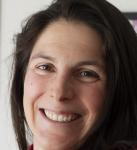Custom-Sized Eco-Citizenship with Mini Mondo Exhibit
There is much excitement about our latest Mini Mondo exhibition! It introduces little ones to eco-citizenship by inviting them to explore a custom-sized world made just for them. Eco-citizenship? This just means thinking green and making everyday choices that help you reduce your carbon footprint. The exhibition’s inclusive design also welcomes other underrepresented audiences, such as immigrant families. Read on to learn how members of the Montréal Science Centre team put their heads together to create this innovative exhibition.
“Wow, perfect!” I blurt out as I see the garden that ‘grows’ foam and leatherette vegetables. “This bin is the perfect height for my 10-month-old. She can easily hold herself up with it.” I can already see her moving around its many spaces. This is truly a little world utterly filled with activities!
Standing near a little house that kids can cover in solar panels made of foam, an urban garden where they can harvest toy vegetables, and a true-to-life bulk food store, among other activity stations, the exhibition’s conceptual designer Élodie Robert explains how the Mini Mondo world is divided into three zones, city, river, and forest, each facilitating exploration and free play. The exhibition is designed to help kids aged 0 to 7 develop their awareness about the environment, she adds.
After nearly two years of work and a fair share of challenges (including a pandemic), Élodie was thrilled to finally see the project come to fruition.
Low to the Ground
“This is the first time we’ve built an exhibition that can welcome toddlers,” explains the Science Centre’s Program Director Cybèle Robichaud. There was no question that designing a space for them was the right move, she adds, recalling the spaces she’d seen in a number of museums designed for kids aged 0 to 3.
Designing for this audience was a first for Élodie Robert too, who also served as project lead. She undertook a lot of reading, many visits, and numerous discussions with experts in the field of early childhood education to ensure that everything was perfectly designed for these mini visitors. The result is an exhibition whose stations are low to the ground and have very little written content and which feature child-safe objects and interactives that engage fine motor skills and the five senses.
“Giving kids a chance to stimulate other senses than just sight is great for their development. And this approach also makes activities more accessible to those with limited vision,” explains Élodie who also worked with Kéroul, a firm specialized in making tourism and culture accessible for those with disabilities.

The production team worked with experts, including Professor Marc Boutet, specialist in environmental education didactics at Université de Sherbrooke, and with artists too. Maud-Fred Côté-Leblanc, Head of Development and Production, hopes this helped the team create an inclusive design that makes the space welcoming and inspiring for families.
Appealing to little ones… and their parents too!
Élodie and I walk into the space for 0- to 2-year-olds, and I can’t help myself from asking: “Can I go through the tunnel?” Here, toddlers can wander the space without fear of getting jostled by bigger kids, she explains as she shows me around.
Then she adds with much excitement: “We’ve also got two new features. They’re really great!” She pushes open the door to the breastfeeding room which features armchairs, easy chairs, a sink, a microwave, and a changing table. “And right next door, there’s a family washroom, with an adult-size toilet and sink and a matching children-sized toilet and sink, and a changing table for bigger kids,” she continues. As Cybèle Robichaud later tells me, “We’re really proud to be offering visitors this space.”
Meeting the Challenge of a More Inclusive Exhibition
“Mini Mondo is also a pilot project for key audiences that don’t often visit the Science Centre: immigrant families,” adds Cybèle.
A number of adjustments had to be made to help us appeal to these families. For example, the very few texts included in the exhibition were translated not only to English, but also to Arabic, Chinese, Creole, and Spanish. And the mini grocery store features products from different cultures too. So, what was the process behind integrating these adaptations?

“Our perspectives are inevitably biased so we couldn’t just design things based on our experiences,” explains Élodie, speaking as exhibition designer. “The audiences we are trying to reach needed to be part of the design process,” she notes, mentioning that the specialized urban ethnography firm Humain Humain was called in to assist the production team.
Together, they organized discussion groups with parents served by the International House of the South Shore and students from two prep classes (sometimes called reception or welcoming classes). “We asked them, for instance, what they put in their lunch boxes,” explains Élodie, who used these answers as cues in the selection of foods included in the “Lunchbox” interactive station in the mini grocery store.
“I have a feeling that the grocery store will be very popular. Kids love to play grocery store. And the end result is really cute with little bread buns and the jars filled with bulk food items,” explains Cybèle, with much enthusiasm.
I am definitely looking forward to my daughter discovering and exploring this mini world. Finally, an exhibition designed just for her. The entire Montréal Science Centre team is very excited too, and curious to see the response of its mini visitors, the eco-citizens of the future.
